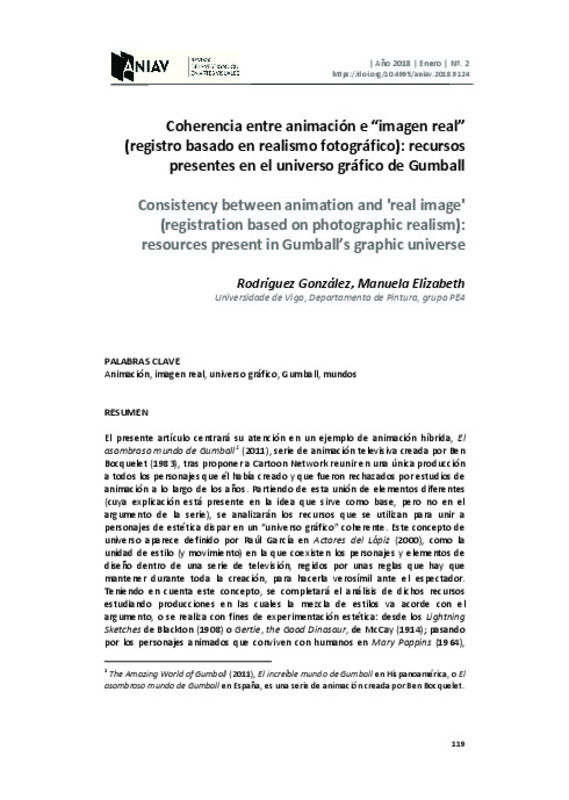|
Resumen:
|
[EN] The present article will focus on an example of hybrid animation, The Amazing World of Gumball (2011), which is a television animation series created by Ben Bocquelet (1983). This series came to life when he proposed ...[+]
[EN] The present article will focus on an example of hybrid animation, The Amazing World of Gumball (2011), which is a television animation series created by Ben Bocquelet (1983). This series came to life when he proposed to Cartoon Network the idea of bringing together in a single production all the characters he had created and which had been rejected by animation studies over the years. Starting from this union of different elements (an explanation that is present in the basic idea, but not in the plot of the series), we will analyze the resources that are used to unite disparate aesthetic characters in a coherent 'graphic universe'. This concept of universe is defined by Raúl García in Actores del Lápiz (2000) as the unit of style (and movement) in which characters and design elements coexist within a television series, governed by rules that must be maintained throughout the creation to make it plausible for the spectator. Taking this concept into account, the analysis of these resources will be completed by the study of productions where the mixture of styles is consistent with the argument, or it is done for aesthetic experimentation. From Blackton's Lightning Sketches (1908) or Gertie, the Good Dinosaur, directed by McCay (1914), going through the animated characters that coexist with humans in Mary Poppins (1964), Who Framed Roger Rabbit? (1988) or Space Jam (1996), to the photographic backgrounds immersed in the experimental animation of The Tatami Galaxy (2010), directed by Masaaki Yuasa.
[-]
[ES] El presente artículo centrará su atención en un ejemplo de animación híbrida, El asombroso mundo de Gumball (2011), serie de animación televisiva creada por Ben Bocquelet (1983), tras proponer a Cartoon Network reunir ...[+]
[ES] El presente artículo centrará su atención en un ejemplo de animación híbrida, El asombroso mundo de Gumball (2011), serie de animación televisiva creada por Ben Bocquelet (1983), tras proponer a Cartoon Network reunir en una única producción a todos los personajes que él había creado y que fueron rechazados por estudios de animación a lo largo de los años. Partiendo de esta unión de elementos diferentes (cuya explicación está presente en la idea que sirve como base, pero no en el argumento de la serie), se analizarán los recursos que se utilizan para unir a personajes de estética dispar en un “universo gráfico” coherente. Este concepto de universo aparece definido por Raúl García en Actores del Lápiz (2000), como la unidad de estilo (y movimiento) en la que coexisten los personajes y elementos de diseño dentro de una serie de televisión, regidos por unas reglas que hay que mantener durante toda la creación, para hacerla verosímil ante el espectador. Teniendo en cuenta este concepto, se completará el análisis de dichos recursos estudiando producciones en las cuales la mezcla de estilos va acorde con el argumento, o se realiza con fines de experimentación estética: desde los Lightning Sketches de Blackton (1908) o Gertie, the Good Dinosaur, de McCay (1914); pasando por los personajes animados que conviven con humanos en Mary Poppins (1964), ¿Quién engañó a Roger Rabbit? (1988), o Space Jam (1996); hasta los fondos de imagen real inmersos en la animación experimental del director Masaaki Yuasa en The Tatami Galaxy(2010).
[-]
|








